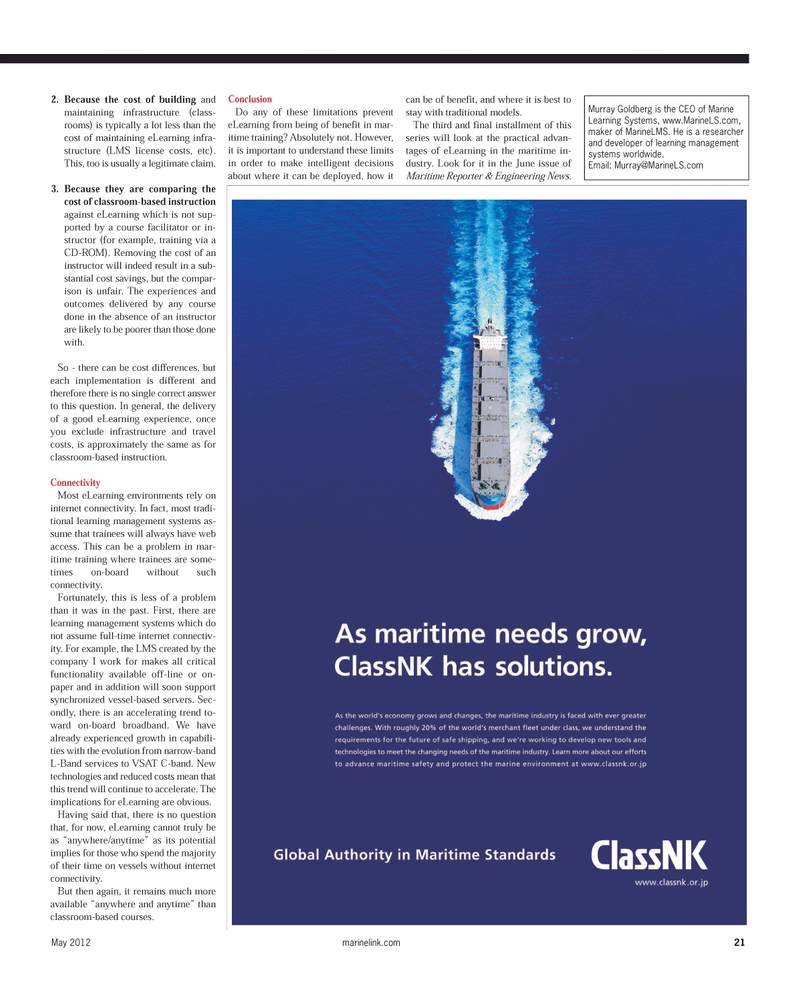
Page 21: of Maritime Reporter Magazine (May 2012)
The Green Ship Edition
Read this page in Pdf, Flash or Html5 edition of May 2012 Maritime Reporter Magazine
2.Because the cost of building andmaintaining infrastructure (class-rooms) is typically a lot less than thecost of maintaining eLearning infra-structure (LMS license costs, etc).This, too is usually a legitimate claim. 3.Because they are comparing the cost of classroom-based instruction against eLearning which is not sup- ported by a course facilitator or in- structor (for example, training via a CD-ROM). Removing the cost of an instructor will indeed result in a sub-stantial cost savings, but the compar- ison is unfair. The experiences and outcomes delivered by any course done in the absence of an instructorare likely to be poorer than those done with.So - there can be cost differences, but each implementation is different and therefore there is no single correct answerto this question. In general, the delivery of a good eLearning experience, once you exclude infrastructure and travel costs, is approximately the same as forclassroom-based instruction.Connectivity Most eLearning environments rely on internet connectivity. In fact, most tradi- tional learning management systems as-sume that trainees will always have web access. This can be a problem in mar- itime training where trainees are some-times on-board without suchconnectivity. Fortunately, this is less of a problem than it was in the past. First, there are learning management systems which donot assume full-time internet connectiv- ity. For example, the LMS created by the company I work for makes all critical functionality available off-line or on- paper and in addition will soon supportsynchronized vessel-based servers. Sec- ondly, there is an accelerating trend to- ward on-board broadband. We have already experienced growth in capabili- ties with the evolution from narrow-band L-Band services to VSAT C-band. New technologies and reduced costs mean thatthis trend will continue to accelerate. The implications for eLearning are obvious. Having said that, there is no question that, for now, eLearning cannot truly be as ?anywhere/anytime? as its potential implies for those who spend the majorityof their time on vessels without internet connectivity. But then again, it remains much more available ?anywhere and anytime? than classroom-based courses.ConclusionDo any of these limitations prevent eLearning from being of benefit in mar- itime training? Absolutely not. However, it is important to understand these limitsin order to make intelligent decisions about where it can be deployed, how it can be of benefit, and where it is best to stay with traditional models.The third and final installment of this series will look at the practical advan- tages of eLearning in the maritime in-dustry. Look for it in the June issue of Maritime Reporter & Engineering News. May 2012 marinelink.com21Murray Goldberg is the CEO of Marine Learning Systems, www.MarineLS.com, maker of MarineLMS. He is a researcher and developer of learning managementsystems worldwide. Email: [email protected] May 12 # 3 (17-24):MR Template 5/8/2012 11:36 AM Page 21

 20
20

 22
22
